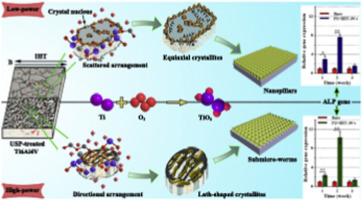当前位置:
X-MOL 学术
›
J. Alloys Compd.
›
论文详情
Our official English website, www.x-mol.net, welcomes your
feedback! (Note: you will need to create a separate account there.)
Evolution of nano/submicro-scale oxide structures on Ti6Al4V achieved by an ultrasonic shot peening-induction heating approach for high-performance surface design of bone implants
Journal of Alloys and Compounds ( IF 5.8 ) Pub Date : 2020-08-01 , DOI: 10.1016/j.jallcom.2020.154876 Ning-bo Li , Sheng-jun Sun , Han-ying Bai , Wen-hua Xu , Gui-yong Xiao , Yi-lin Zhang , Yu-peng Lu
Journal of Alloys and Compounds ( IF 5.8 ) Pub Date : 2020-08-01 , DOI: 10.1016/j.jallcom.2020.154876 Ning-bo Li , Sheng-jun Sun , Han-ying Bai , Wen-hua Xu , Gui-yong Xiao , Yi-lin Zhang , Yu-peng Lu

|
Abstract Modified layers with multiscale structures have been extensively explored and rationally designed on Ti-based orthopedic implants recently, since the remarkable improvement of biomedical properties. In consideration of the inefficiency, costliness and waste products of existing technologies, herein, we proposed the ultrasonic shot peening and induction heating protocol to construct the micro-nano complex oxide structures on Ti6Al4V in term of its advantages of environmental friend, rapid heating, low-cost and easy to process. With the USP pretreatment and induction heating, the nonuniform oxide crystallites firstly appeared on smooth surface and successfully grow up into the well-distributed TiO2 nanocrystallites, and transformed to netlike structures with submicro-sized worms when subjected to high-power of shot peening, which was significantly influenced by the microstructural evolution of alloy matrix. The submicro/nano-structured oxide layers mainly contained rutile/anatase TiO2 and little Al2O3 between grain boundaries, successively enhanced the surface roughness and wettability, and tended to form the hydrophilic surfaces. The adhesion strength of the oxide layers to substrates and hardness were also distinctly increased with increasing the IHT period from 20 to 35 s. In vitro BMSCs culturing proved that the prepared submicro/nano-scale oxide layers possessed favorable cell adhesion and proliferation, and further improved the osteogenic differentiation. The novelty of this work was to explored the evolution law of submicro-and nano-scale structures in osteogenic differentiation, and further better clinical application of Ti-based biomaterials.
中文翻译:

通过超声波喷丸感应加热方法实现 Ti6Al4V 上纳米/亚微米级氧化物结构的演变,用于骨植入物的高性能表面设计
摘要 近年来,随着生物医学性能的显着提高,钛基骨科植入物上的多尺度结构改性层得到了广泛的探索和合理设计。考虑到现有技术效率低、成本高、废品多等问题,本文利用超声波喷丸强化和感应加热方案在Ti6Al4V上构建微纳米复合氧化物结构,具有环保、升温快、低等优点。 -成本高且易于加工。通过USP预处理和感应加热,不均匀的氧化物微晶首先出现在光滑的表面,并成功成长为分布均匀的TiO2纳米微晶,并在受到高功率喷丸处理时转变为具有亚微米级蠕虫的网状结构,受合金基体显微组织演变的显着影响。亚微/纳米结构氧化层主要含有金红石/锐钛矿型TiO2,晶界间含有少量Al2O3,依次增强了表面粗糙度和润湿性,并倾向于形成亲水性表面。随着 IHT 时间从 20 秒增加到 35 秒,氧化层对基材的粘附强度和硬度也明显增加。体外 BMSCs 培养证明,制备的亚微/纳米氧化层具有良好的细胞粘附和增殖,进一步改善了成骨分化。本工作的创新之处在于探索了亚微纳米级结构在成骨分化中的演化规律,进一步更好地促进钛基生物材料的临床应用。
更新日期:2020-08-01
中文翻译:

通过超声波喷丸感应加热方法实现 Ti6Al4V 上纳米/亚微米级氧化物结构的演变,用于骨植入物的高性能表面设计
摘要 近年来,随着生物医学性能的显着提高,钛基骨科植入物上的多尺度结构改性层得到了广泛的探索和合理设计。考虑到现有技术效率低、成本高、废品多等问题,本文利用超声波喷丸强化和感应加热方案在Ti6Al4V上构建微纳米复合氧化物结构,具有环保、升温快、低等优点。 -成本高且易于加工。通过USP预处理和感应加热,不均匀的氧化物微晶首先出现在光滑的表面,并成功成长为分布均匀的TiO2纳米微晶,并在受到高功率喷丸处理时转变为具有亚微米级蠕虫的网状结构,受合金基体显微组织演变的显着影响。亚微/纳米结构氧化层主要含有金红石/锐钛矿型TiO2,晶界间含有少量Al2O3,依次增强了表面粗糙度和润湿性,并倾向于形成亲水性表面。随着 IHT 时间从 20 秒增加到 35 秒,氧化层对基材的粘附强度和硬度也明显增加。体外 BMSCs 培养证明,制备的亚微/纳米氧化层具有良好的细胞粘附和增殖,进一步改善了成骨分化。本工作的创新之处在于探索了亚微纳米级结构在成骨分化中的演化规律,进一步更好地促进钛基生物材料的临床应用。











































 京公网安备 11010802027423号
京公网安备 11010802027423号